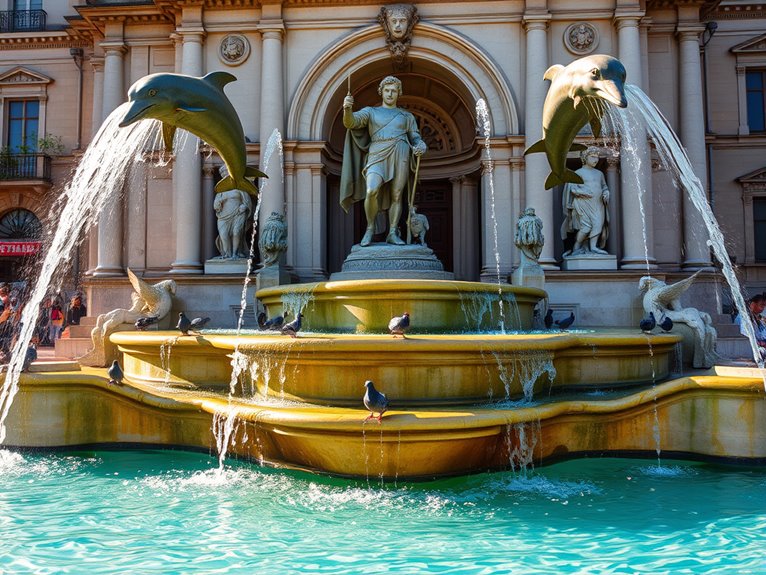
7 Most Beautiful Fountains in Paris
I've discovered seven stunning fountains in Paris that'll take your breath away! The majestic Latona Fountain at Versailles showcases Louis XIV's grandeur, while the romantic Medici Fountain offers peaceful reflection in Luxembourg Gardens. Don't miss the historic Fontaine des Innocents, Paris's oldest public fountain, or the playful Stravinsky Fountain near Centre Pompidou. The Gothic Saint-Michel, Dancing Waters of Trocadéro, and twin fountains at Place de la Concorde round out these magnificent water features. Let's explore what makes each one uniquely special.
The Majestic Latona Fountain at Palace of Versailles
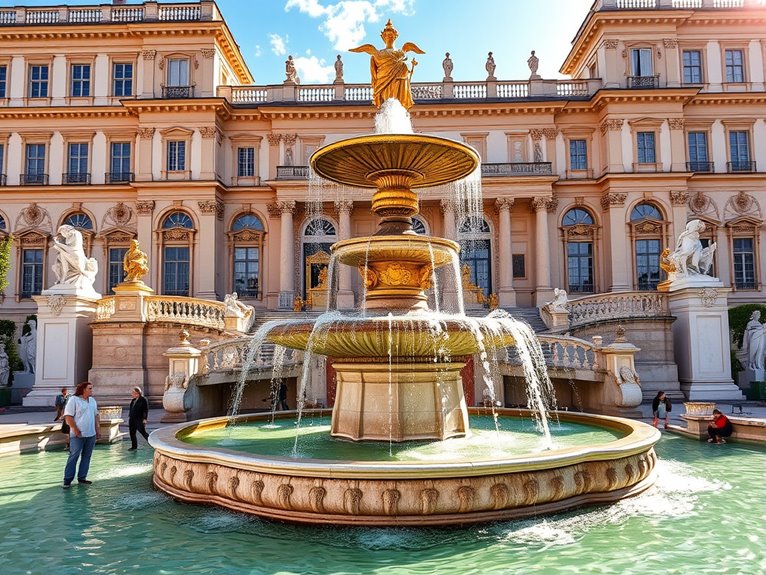
The Latona Fountain stands as one of the most magnificent water features in the Palace of Versailles gardens, representing the mythological story of Latona, mother of Apollo and Diana. Created between 1668 and 1670 under Louis XIV's reign, this stunning baroque fountain showcases the goddess protecting her children from the Lycian peasants, whom Jupiter transformed into frogs and lizards as punishment for their cruelty.
Located at the center of the parterre directly below the palace, the Latona Fountain serves as the focal point of the gardens' main perspective, stretching from the palace to the Grand Canal. The fountain's recent restoration in 2015 restored its original splendor, revealing intricate marble work, gleaming gilded lead figures, and a sophisticated hydraulic system that creates spectacular water effects during the Musical Fountains Shows.
Quick Facts:
- Best visiting times: Tuesday-Sunday, 9:00 AM – 6:30 PM (April-October)
- Musical Fountains Shows: Saturdays and Sundays (April-October)
- Photography tips: Early morning for best lighting, fewer crowds
- Ticket prices: Included in Palace gardens admission (€9.50-€20)
- Peak water shows: 11:00 AM – 12:00 PM and 3:30 PM – 5:00 PM
- Accessibility: Paved pathways, wheelchair accessible
Main Features:
The fountain's distinctive tiered design comprises four concentric marble basins that cascade water in a mesmerizing display. The central figure of Latona, crafted in white Carrara marble, stands atop the highest tier, while 24 frogs, lizards, and human-animal hybrid figures occupy the lower levels, each spouting water in unique patterns. The surrounding parterres feature meticulously maintained topiary and seasonal flower displays that complement the fountain's grandeur.
Insider tip: During the Musical Fountains Shows, position yourself at the upper terrace near the palace steps for the most dramatic view of both the fountain and its reflection in the surrounding pools, while enjoying the carefully choreographed baroque music accompaniment.
Pro Tips:
The best viewing experience combines timing and positioning. Visit during the "Grande Eaux" (Musical Fountains Shows) when all water features are operational, but arrive 30 minutes before the show begins to secure a prime viewing spot. The afternoon light creates the most dramatic effects as it hits the water jets and gilded sculptures, making it ideal for photography. Consider bringing a small folding chair or cushion, as the shows can last up to 90 minutes.
Practical Advice:
Weather conditions greatly impact the fountain experience. Wind can affect water patterns, while sunny days create rainbow effects in the spray. Check the weather forecast and fountain schedule before visiting, as not all features operate daily. Bring water-resistant footwear during fountain shows, as pathways can become wet from spray. The area around the fountain can become crowded during peak season (July-August), so consider visiting during shoulder seasons (May-June or September) for a more relaxed experience. Remember that the fountain's appearance changes throughout the day as sunlight shifts, offering different photographic opportunities at various times.
Medici Fountain: A Renaissance Marvel in Luxembourg Gardens
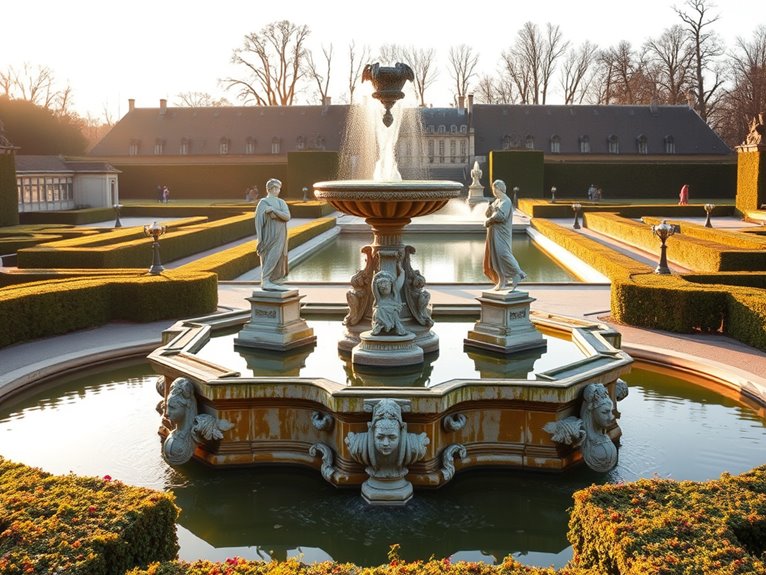
Beautiful Fountains in Paris: The Medici Fountain
—————————————————
The Medici Fountain stands as one of Paris's most enchanting Renaissance treasures, nestled within the verdant embrace of the Luxembourg Gardens. Commissioned in 1630 by Marie de Medici, this architectural masterpiece combines Italian elegance with French artistic sensibility, creating a peaceful haven that has captivated visitors for nearly four centuries.
This monumental fountain tells a story of love, power, and artistic brilliance through its mythological sculptures and architectural details. Visitors are drawn to its long reflecting pool, dramatic grotto design, and the central sculpture depicting Polyphemus discovering Acis and Galatea – a scene that perfectly captures both the romantic and dramatic elements of Renaissance art.
Quick Facts:
- Best visiting hours: Early morning (8-10 AM) or late afternoon (4-6 PM)
- Photography conditions: Best on overcast days or during golden hour
- Admission: Free with Luxembourg Gardens entry
- Opening hours: 7:30 AM to sunset (varies seasonally)
- Best season: Spring through fall, particularly April-October
- Accessibility: Wheelchair accessible via garden paths
The Fountain's Architecture
The fountain's design features a central grotto flanked by massive rusticated columns, crowned with the Medici family coat of arms. The primary focal point is the Mannerist-style sculpture group, created by Auguste Ottin in 1866 during the fountain's renovation. The 50-meter-long basin reflects the surrounding trees and architecture, creating stunning photo opportunities throughout the day.
Historical Significance
Originally located on a different site, the fountain was moved to its current location in 1864 during Baron Haussmann's renovation of Paris. The relocation allowed for the addition of the long reflecting pool and new sculptural elements, enhancing its original design while preserving its historical character. An often-overlooked detail is the ancient Egyptian-style obelisk hidden within the grotto, a nod to Marie de Medici's fascination with classical antiquity.
Pro Tips:
The Medici Fountain offers its most magical moments during specific times and conditions. Visit just after rain when the reflecting pool mirrors the architecture perfectly, or arrive at opening time when morning mist creates an ethereal atmosphere around the sculptures. For photographers, the late afternoon light filtering through the surrounding chestnut trees creates dramatic shadows and highlights on the fountain's façade.
Practical Advice:
Combine your visit with a full exploration of the Luxembourg Gardens, allowing at least 30 minutes to appreciate the fountain's details. Bring a small sketchbook or camera, as photography is permitted without tripods. The nearby cafes offer perfect spots for reflection and rest after viewing the fountain, particularly the historic Café de la Maison des Écrivains just outside the garden's gates.
Fontaine Saint-Michel: Gothic Splendor on the Left Bank
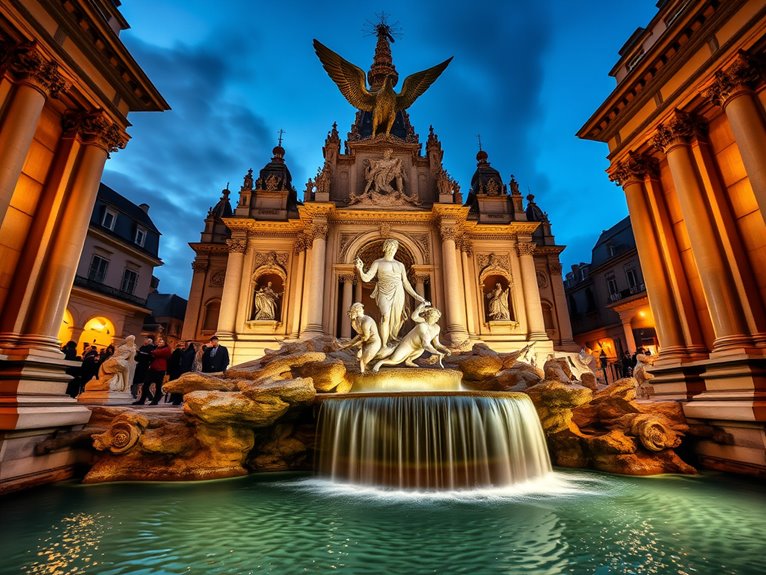
The Fontaine Saint-Michel stands as one of Paris's most dramatic and imposing fountains, commanding attention at the heart of Place Saint-Michel in the Latin Quarter. Created during Baron Haussmann's renovation of Paris in 1860, this monumental Neo-Renaissance masterpiece depicts the epic battle between good and evil, with Archangel Michael vanquishing the devil as its central theme.
The fountain serves as both a vital meeting point for locals and visitors alike and a reflection of French Second Empire architectural grandeur. Rising nearly 26 meters high and spanning 15 meters wide, its imposing presence against the backdrop of classic Parisian buildings creates one of the Left Bank's most photographed landmarks, particularly stunning when illuminated at night.
Quick Facts:
- Best visiting times: Early morning (7-9 AM) or evening (after 8 PM) for fewer crowds
- Photography conditions: Best at dusk when artificial lighting combines with natural light
- Access: Free, 24/7 viewing
- Metro: Saint-Michel (Line 4)
- Best viewing spot: Café terrace at Place Saint-Michel
- Maintenance periods: Usually spring (March-April)
The centerpiece of the fountain features a dramatic bronze statue of Saint Michael defeating Satan, created by Francisque-Joseph Duret. The composition is framed by red marble columns and adorned with four green bronze dragons that spout water into the basin below. Gabriel Davioud designed the architectural elements, incorporating different colored marbles and stones to create a polychromatic effect typical of High Victorian Gothic style. The fountain marks the meeting point of Boulevard Saint-Michel and Saint-Germain, making it an ideal reference point for exploring the Latin Quarter.
Insider tip: The face of Lucifer is said to be modeled after Napoleon III's critic, a subtle political statement hidden in plain sight. Look closely at the devil's features during daytime visits for the best view of this historical detail.
Pro Tips:
The fountain's most dramatic photographs can be captured from the small island in the middle of the intersection, but exercise caution with traffic. For the best experience, visit during the "blue hour" just after sunset when the fountain's lighting creates a magical atmosphere against the darkening sky. Consider pairing your visit with dinner at one of the surrounding traditional French bistros, as this area comes alive in the evening hours.
Practical Advice:
While the fountain is freely accessible year-round, be mindful of pickpockets in this busy tourist area, especially when photographing. The surrounding cafés offer excellent vantage points for viewing and photographing the fountain, but prices tend to be higher due to the prime location. Consider purchasing a drink to secure a prime viewing spot, particularly during peak tourist seasons (June-August). The area can become quite crowded during summer evenings, so plan accordingly if you're seeking a more peaceful viewing experience.
Dancing Waters of Trocadéro Gardens
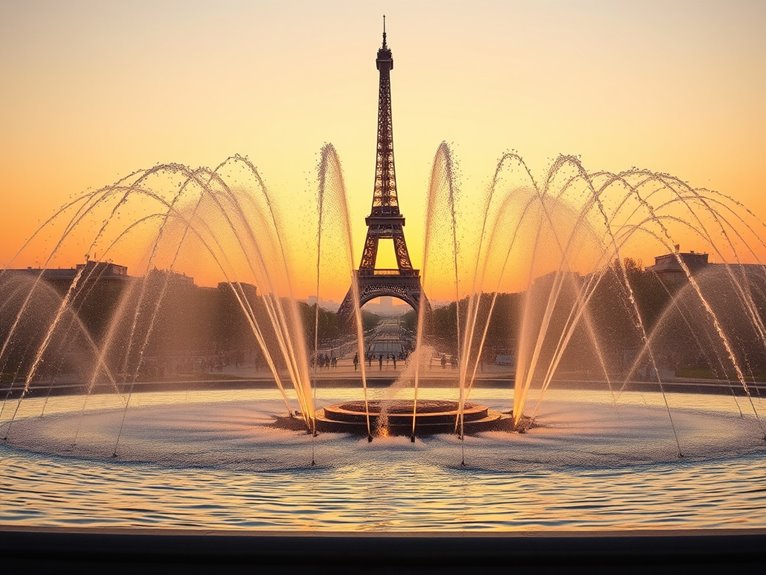
The magnificent fountains of Trocadéro Gardens stand as one of Paris's most spectacular water displays, creating a dramatic foreground to the iconic Eiffel Tower. These cascading fountains, built for the 1937 World's Fair, feature 20 water cannons that shoot powerful jets into the air, creating an intricate choreography of water and light that mesmerizes visitors throughout the day.
The fountains consist of a series of cascading basins that step down the hillside between the Palais de Chaillot and the Seine River. During scheduled times, the water display transforms into a sophisticated aquatic ballet, with jets varying in height and intensity, creating patterns that seem to dance in harmony with the surrounding architectural elements.
Quick Facts:
- Best viewing times: 11:00 AM to sunset (water shows every 30 minutes)
- Free admission to gardens and fountain viewing
- Photography best during golden hour (1-2 hours before sunset)
- Water displays operate March through October
- Accessible via Metro stations Trocadéro or Iéna
- Wheelchair accessible from multiple entry points
Main Water Features:
The central fountain pool spans 70 meters in width and features powerful water cannons capable of shooting jets up to 12 meters high. The synchronized water display creates geometric patterns and graceful arcs, while the stepped fountains on either side produce a constant flow of water that creates a soothing ambient sound. The design incorporates bronze sculptures of sea horses and allegorical figures that add classical elements to the modern water engineering.
Viewing Platforms:
The elevated terrace of the Palais de Chaillot provides the premier viewing spot for both the fountains and the Eiffel Tower. This vantage point allows visitors to capture stunning photographs where the dancing waters frame the Iron Lady. The marble balustrades offer perfect photo opportunities, particularly during morning hours when crowds are thinner.
Garden Integration:
The fountains are seamlessly integrated into the surrounding gardens, which feature manicured lawns, seasonal flower beds, and tree-lined pathways. The water features create a microclimate that makes the gardens a revitalizing retreat during summer months, while the sound of flowing water masks urban noise.
Pro Tips:
Visit during the first morning show to avoid crowds and capture reflection shots in the still water. Photographers should position themselves on the upper terrace during golden hour, when the setting sun creates magical lighting effects through the water spray. For the most dramatic photos, visit on windy days when the water spray creates natural special effects.
Practical Advice:
While the fountains operate daily during the warm season, maintenance work occasionally requires brief shutdowns. Check the Paris municipal website for current schedules and any planned maintenance. During peak summer months, bring water and sun protection as the open plaza offers limited shade. The area around the fountains can become slippery when wet, so wear appropriate footwear. Consider combining your visit with the nearby Passy neighborhood for authentic Parisian cafes and boutiques that most tourists overlook.
Fontaine Des Innocents: Paris's Oldest Public Fountain
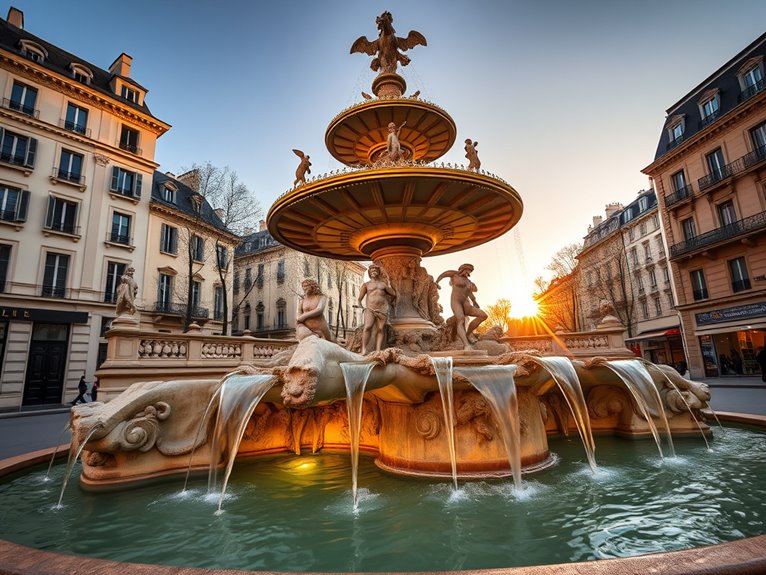
Standing proudly in the heart of Paris's 1st arrondissement, the Fontaine des Innocents represents a remarkable piece of French Renaissance architecture and holds the distinction of being Paris's oldest public fountain. Originally constructed in 1549 during the reign of King Henry II, this iconic monument has witnessed centuries of Parisian history while maintaining its elegant presence in the modern city landscape.
The fountain's historical significance extends beyond its age – it marks a pivotal moment in French architectural history as one of the earliest examples of French Renaissance sculpture. Originally designed as a wall fountain with three sides, it was later transformed into a free-standing four-sided structure during the late 18th century, demonstrating the evolution of Parisian urban planning and architectural innovation.
Quick Facts:
- Best visiting times: Early morning (8-10 AM) or late afternoon (4-6 PM)
- Location: Place Joachim-du-Bellay, 1st arrondissement
- Photography tips: Morning light provides ideal conditions
- Accessibility: 24/7, free public access
- Nearest Metro: Les Halles (lines 4, 7, 11, 14)
- Best viewing season: Spring through fall
- Crowd levels: Moderate throughout the day
Historical and Architectural Significance:
The fountain showcases the masterful work of sculptor Jean Goujon and architect Pierre Lescot, featuring elegant nymph sculptures and detailed Renaissance reliefs. The limestone structure rises 12.5 meters high, decorated with masterful sculptures of water nymphs, which have become symbols of French Renaissance art. Insider tip: Look for the barely visible ancient mason marks on the lower stones, which reveal the fountain's original construction techniques.
Location and Surroundings:
Situated in the modern-day Square des Innocents, the fountain stands where the infamous Cemetery of the Innocents once existed. Today, it serves as a central meeting point surrounded by cafes and shops. The square often hosts local artists and performers, particularly during summer evenings. Insider tip: The small café directly facing the fountain's eastern side offers the best vantage point for photography while enjoying a traditional French coffee.
Pro Tips:
For the most rewarding experience, visit during the "golden hour" just before sunset when the limestone takes on a warm, honey-colored glow. Photographers should bring a wide-angle lens to capture the full height of the structure, and a tripod for low-light conditions. Consider visiting during light rain, when water streaming down the sculptures creates a particularly dramatic effect that few tourists witness.
Practical Advice:
While the fountain is always accessible, the surrounding area can get quite busy during peak tourist season (June-August). Visit early morning or late evening to avoid crowds and get the best photos. Be mindful of pickpockets in this touristic area, and consider combining your visit with the nearby Les Halles shopping center or the Centre Pompidou, both within easy walking distance. The square offers limited seating, so bring a portable stool if you plan to sketch or photograph for extended periods.
The Stravinsky Fountain's Modern Whimsy
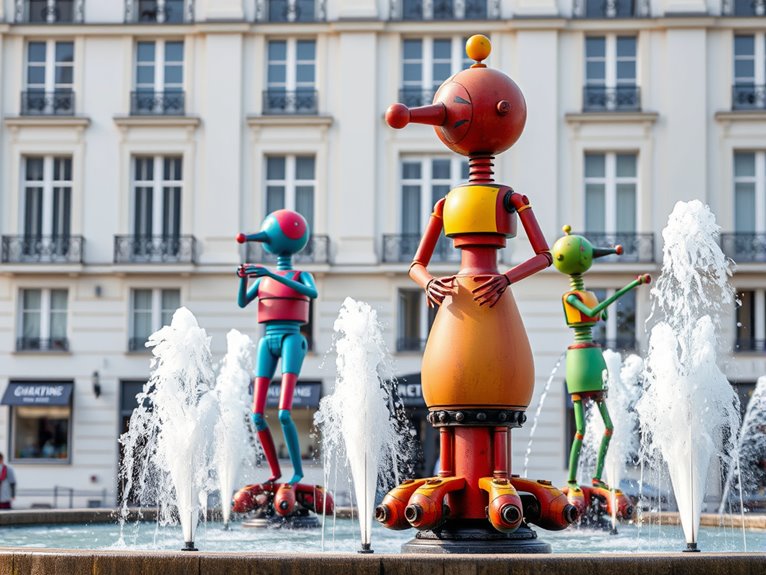
Nestled in the heart of Paris, adjacent to the Centre Pompidou, the Stravinsky Fountain stands as a vibrant symbol of modern artistic expression in the City of Light. Created in 1983 by artists Jean Tinguely and Niki de Saint Phalle, this playful fountain features 16 whimsical mechanical sculptures that dance and spray water in a choreographed celebration of composer Igor Stravinsky's most famous works.
This kinetic art installation represents a perfect marriage between Paris's classical heritage and its contemporary spirit. The fountain's colorful, moving sculptures – ranging from bright red lips to musical notes – create a striking contrast against the historic architecture of the Marais district, making it one of the city's most photographed modern landmarks and a must-visit destination for art enthusiasts and casual visitors alike.
Quick Facts:
- Best viewing times: 10 AM – 6 PM (optimal lighting for photos)
- Cost: Free to view
- Operating season: Year-round, water features active March-October
- Photography tips: Morning light best captures colors
- Accessibility: Fully wheelchair accessible
- Nearby amenities: Cafés, Centre Pompidou, public restrooms
- Peak crowds: 2-5 PM daily, especially weekends
The Fountain's Key Elements:
The black mechanical sculptures by Tinguely represent the darker, mechanical aspects of Stravinsky's music, while Saint Phalle's colorful figures embody its lighter, more melodic elements. Located in Place Igor Stravinsky, the fountain occupies a shallow basin of 580 square meters, with each sculpture representing different aspects of Stravinsky's compositions, including "The Firebird" and "The Rite of Spring." Insider tip: The sculptures rotate at different speeds throughout the day, with the most active performances occurring at quarter past each hour.
The interaction between water, movement, and art creates an ever-changing display that varies with weather conditions and seasons. During summer months, the mist from the fountains provides a rejuvenating respite from Paris's heat, while in winter, the sculptures continue their mechanical dance without water, offering a different but equally fascinating experience. Less known fact: The mechanical components are maintained monthly by specialized technicians who adjust each sculpture's movement patterns seasonally.
Pro Tips:
Visit during the "golden hour" just before sunset when the play of light on the water creates magical photo opportunities. The reflection of the setting sun on the colorful sculptures produces stunning visual effects, especially when captured from the elevated plaza of the Centre Pompidou. For the best experience, combine your visit with the Centre Pompidou's late-night openings on Thursdays, when the fountain area is less crowded and beautifully illuminated.
Practical Advice:
The surrounding area can get quite busy with street performers and tourists, particularly during peak hours. Plan your visit for early morning or during lunch hours when local workers are indoors. Bring a wide-angle lens if you're photographing the fountain, as the installation's scale is best captured from a distance. The nearby cafés offer excellent vantage points for observation while enjoying a coffee, though prices tend to be higher due to the prime location – consider the lesser-known establishments on Rue Saint-Merri for more reasonable options while still maintaining a view of the fountain.
Fountains of Place De La Concorde: Monuments to Maritime Glory
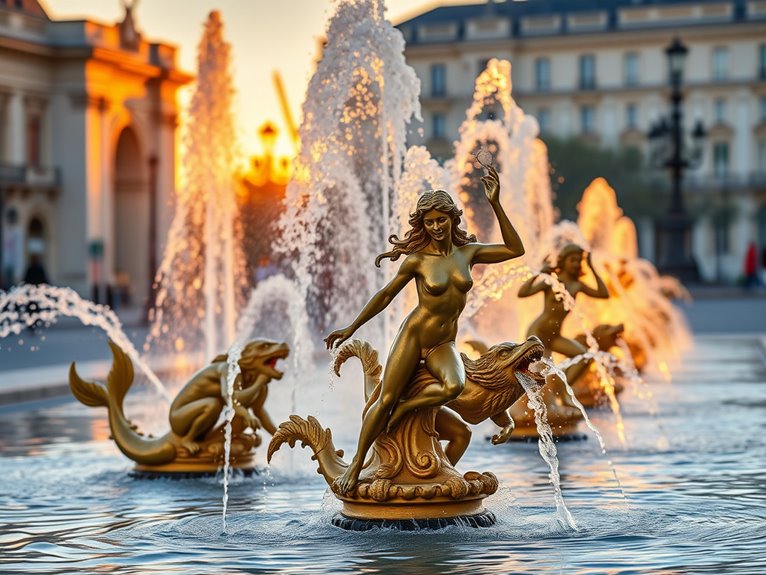
The majestic fountains of Place de la Concorde stand as enduring symbols of France's maritime prowess, commissioned during the reign of Louis-Philippe in 1836. These twin fountains – the Fontaine des Fleuves (Fountain of Rivers) and Fontaine des Mers (Fountain of Seas) – frame the ancient Egyptian obelisk at the square's center, creating one of Paris's most photographed architectural ensembles.
These masterpieces, designed by Jacques-Ignace Hittorff, represent more than mere decorative elements; they tell the story of France's maritime commerce and naval power through intricate sculptures and symbolic representations. Each fountain features magnificent neoclassical figures depicting various aspects of maritime life, from river navigation to ocean commerce, making them essential stops for both architecture enthusiasts and history buffs.
Quick Facts:
- Best viewing times: Dawn and dusk for ideal lighting
- Operating hours: 24/7, illuminated from sunset to 1 AM
- Photography tips: Early morning for fewer tourists
- Free admission to the plaza
- Most crowded: 11 AM – 4 PM
- Best season: Spring and Fall for comfortable temperatures
Fontaine des Mers (Maritime Fountain):
Located on the south side of the square, this fountain celebrates France's maritime power. The central figures represent the Mediterranean and Atlantic oceans, surrounded by allegories of pearl fishing, coral harvesting, and fish catching. The fountain operates daily, with its most spectacular display during evening illuminations. Insider tip: The best photos can be captured from the northeast corner, where the fountain aligns perfectly with the Champs-Élysées in the background.
Fontaine des Fleuves (River Fountain):
The northern fountain represents France's major rivers and river commerce. Its sculptures depict the Rhine and Rhône rivers, along with French agriculture and grape harvesting. The fountain features unique water effects that change throughout the day. Lesser-known fact: The faces of the river gods were modeled after actual river workers of the period.
Pro Tips:
Visit during the "Golden Hour" (one hour before sunset) when the natural light creates stunning reflections on the water and bronze sculptures. For the best experience, combine your fountain visit with the Paris City Free Walking Tour, which stops here daily at 10 AM and 2:30 PM. The guides often share fascinating historical details about the fountains' construction and symbolism that aren't found in guidebooks.
Practical Advice:
The Place de la Concorde can be extremely busy and exposed to the elements. Visit early morning or evening to avoid both crowds and intense sun. The nearest metro stations are Concorde (Lines 1, 8, and 12) and Tuileries (Line 1). Bring a wide-angle lens for photography, and consider visiting during winter when the fountains' water effects create unique ice formations during freezing temperatures.
